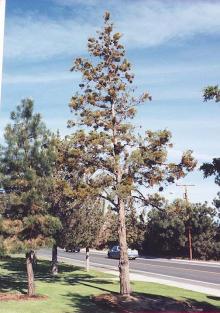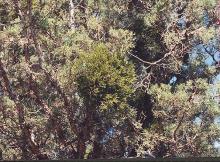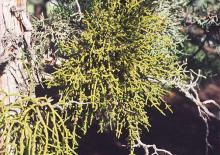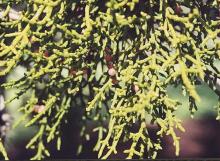Cause Phoradendron juniperinum and P. densum. A parasitic seed plant, mistletoe depends on its host for much of its water and mineral nutrients. Fruit can be toxic to humans and livestock, but birds eat and disperse them to new trees. P. juniperinum belongs to the same genus as the mistletoe that affects oak but will not grow on oak or other conifers. The species on juniper are principally leafless. Found in central and southern Oregon on western juniper.
A population of Juniperus monosperma was more successful at dispersing when infected with P. juniperinum. Birds like berries from both plants and juniper seeds germinate better after being digested. But while juniper is erratic in fruit production, the mistletoe is consistent. The mistletoe, which helps maintain bird populations, thereby helps disperse both plants.
Symptoms Mature stems are woody with smooth surfaces. Leaves are scale-like and about 1 mm long. Flowers are produced from July to September. The male inflorescence has one or two segments, each with five to nine flowers. The female inflorescence has one segment with two flowers. Fruit is pinkish white, smooth, and about 4 mm in diameter.
Cultural control Cut out affected juniper branches. New sprouts will grow if only the aerial shoots are removed.
Reference van Ommeren, R.J., and Whitham, T.G. 2002. Changes in interactions between juniper and mistletoe mediated by shared avian frugivores: parasitism to potential mutualism. Oecologia, 130:281-288.





